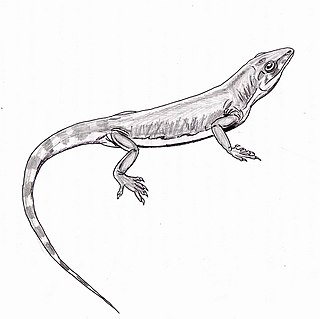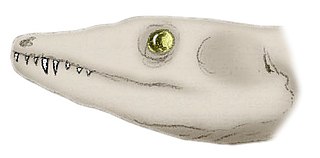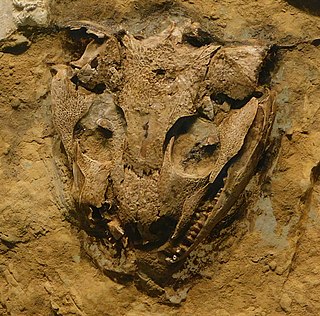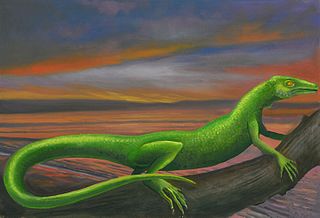
Dissorophidae is an extinct family of medium-sized, temnospondyl amphibians that flourished during the late Carboniferous and early Permian periods. The clade is known almost exclusively from North America.

Eupelycosauria is a large clade of animals characterized by the unique shape of their skull, encompassing all mammals and their closest extinct relatives. They first appeared 308 million years ago during the Early Pennsylvanian epoch, with the fossils Archaeothyris and perhaps an even earlier genus, Protoclepsydrops, representing just one of the many stages in the evolution of mammals, in contrast to their earlier amniote ancestors.

Caseasauria is one of the two main clades of early synapsids, the other being the Eupelycosauria. Caseasaurs are currently known only from the Late Carboniferous and the Permian, and include two superficially different families, the small insectivorous or carnivorous Eothyrididae, and the large, herbivorous, potentially aquatic Caseidae. These two groups share a number of specialised features associated with the morphology of the snout and external naris.

Varanopidae is an extinct family of amniotes that resembled monitor lizards and may have filled a similar niche, hence the name. Typically, they are considered synapsids that evolved from an Archaeothyris-like synapsid in the Late Carboniferous. However, some recent studies have recovered them being taxonomically closer to diapsid reptiles. A varanopid from the latest Middle Permian Pristerognathus Assemblage Zone is the youngest known varanopid and the last member of the "pelycosaur" group of synapsids.

Mycterosaurus is an extinct genus of synapsids belonging to the family Varanopidae. It is classified in the varanopid subfamily Mycterosaurinae. Mycterosaurus is the most primitive member of its family, existing from 290.1 to 272.5 MYA, known to Texas and Oklahoma. It lacks some features that its advanced relatives have.

Varanops is an extinct genus of Early Permian varanopid synapsids known from Texas and Oklahoma of the United States. It was first named by Samuel Wendell Williston in 1911 as a second species of Varanosaurus, Varanosaurus brevirostris. In 1914, Samuel W. Williston reassigned it to its own genus and the type species is Varanops brevirostris.

Trematopidae is a family of dissorophoid temnospondyl spanning the late Carboniferous to the early Permian. Together with Dissorophidae, the family forms Olsoniformes, a clade comprising the medium-large terrestrial dissorophoids. Trematopids are known from numerous localities in North America, primarily in New Mexico, Oklahoma, and Texas, and from the Bromacker quarry in Germany.

Aerosaurus is an extinct genus within Varanopidae, a family of non-mammalian synapsids. It lived between 252-299 million years ago during the Early Permian in North America. The name comes from Latin aes (aeris) “copper” and Greek sauros “lizard,” for El Cobre Canyon in northern New Mexico, where the type fossil was found and the site of former copper mines. Aerosaurus was a small to medium-bodied carnivorous synapsid characterized by its recurved teeth, triangular lateral temporal fenestra, and extended teeth row. Two species are recognized: A. greenleeorum (1937) and A. wellesi (1981).
Elliotsmithia is a small varanopid synapsid found from the late Middle Permian of South Africa. It is the sole basal synapsid "pelycosaur" known from the supercontinent Gondwana and only two specimens have been yielded to date. Its species name longiceps is derived from Latin, meaning "long head". Both known Elliotsmithia fossils were recovered from Abrahamskraal Formation rocks—within the boundaries of the Tapinocephalus Assemblage Zone—of the lower Beaufort Group.
Pyozia is an extinct genus of basal Middle Permian varanopid synapsids known from Russia. It was first named by Jason S. Anderson and Robert R. Reisz in 2004 and the type species is Pyozia mesenensis. Pyozia mesenensis is known from the holotype PIN 3717/33, a three-dimensionally preserved partial skeleton including a nearly complete skull. It was collected from the Krasnoschelsk Formation, dating to the Capitanian stage of the Guadalupian epoch, about 265.8-263 million years ago.

Ianthodon is an extinct genus of basal sphenacodont synapsids from the Late Carboniferous about 304 million years ago. The taxon was discovered and named by Kissel & Reisz in 2004. The only species in the taxon, Ianthodon schultzei, was found by separating it from a block that also contained the remains of Petrolacosaurus and Haptodus. The evolutionary significance of the taxon wasn't realized until a publication in 2015. The fossil of this organism was discovered in Garnett, Kansas.

Heleosarus scholtzi is an extinct species of basal synapsids, known as pelycosaurs, in the family of Varanopidae during the middle Permian. At first H. scholtzi was mistakenly classified as a diapsid. Members of this family were carnivorous and had dermal armor, and somewhat resembled monitor lizards. This family was the most geologically long lived, widespread, and diverse group of early amniotes. To date only two fossils have been found in the rocks of South Africa. One of these fossils is an aggregation of five individuals.

Orovenator is an extinct genus of diapsid from Lower Permian deposits of Oklahoma, United States. It is known from two partial skulls from the Richards Spur locality in Oklahoma. The holotype OMNH 74606 consists of a partial skull preserving snout and mandible, and the referred specimen, OMNH 74607, a partial skull preserving the skull roof, vertebrae and palatal elements. It was first named by Robert R. Reisz, Sean P. Modesto and Diane M. Scott in 2011 and the type species is Orovenator mayorum. The generic name means "mountain", oro, in Greek in reference to the Richards Spur locality, which was mountainous during the Permian period and "hunter", venator, in Latin. The specific name honours Bill and Julie May. Orovenator is the oldest and most basal neodiapsid to date.

Apsisaurus is an extinct genus of Early Permian varanopid synapsids known from Texas of the United States. It was first named by Michel Laurin in 1991 and the type species is Apsisaurus witteri. Apsisaurus witteri is known from the holotype MCZ 1474, a three-dimensionally preserved partial skeleton including an incomplete skull and mandibles. The skull roof of Archeria is also articulated to the postcranial skeleton. It was collected in the Archer City Bonebed 1 site, from the Archer City Formation of the Wichita Group, dating to the Early Permian epoch. Apsisaurus was formerly assigned as an "eosuchian" diapsid. In 2010, it was redescribed by Robert R. Reisz, Michel Laurin and David Marjanović; their phylogenetic analysis found it to be a basal varanopid synapsid.

Euconcordia is an extinct genus of Late Carboniferous captorhinid known from Greenwood County, Kansas of the United States.

Younginidae is an extinct family of diapsid reptiles from the Late Permian and Early Triassic. In a phylogenetic context, younginids are near the base of the clade Neodiapsida. Younginidae includes the species Youngina capensis from the Late Permian of South Africa and Thadeosaurus colcanapi from the Late Permian and Early Triassic of Madagascar. Heleosuchus griesbachi from the Late Permian of South Africa may also be a member of the family.
Ascendonanus is an extinct genus of varanopid amniote from the Early Permian of Germany. It is the earliest specialized arboreal (tree-living) vertebrate currently known and resembled a small lizard, although it was related to mammals. The fossils of Ascendonanus are of special scientific importance because they include remains of skin, scales, scutes, bony ossicles, and body outlines, indicating that some of the oldest relatives of mammals had a scaly "reptilian-type" appearance. The animal was about 40 cm long, with strongly curved claws, short limbs, a slender, elongated trunk, and a long tail. It would have preyed on insects and other small arthropods.

Richards Spur is a Permian fossil locality located at the Dolese Brothers Limestone Quarry north of Lawton, Oklahoma. The locality preserves clay and mudstone fissure fills of a karst system eroded out of Ordovician limestone and dolostone, with the infilling dating to the Artinskian stage of the early Permian (Cisuralian), around 289 to 286 million years ago. Fossils of terrestrial animals are abundant and well-preserved, representing one of the most diverse Paleozoic tetrapod communities known. A common historical name for the site is Fort Sill, in reference to the nearby military base. Fossils were first reported at the quarry by workers in 1932, spurring a wave of collecting by local and international geologists. Early taxa of interest included the abundant reptile Captorhinus and microsaurs such as Cardiocephalus and Euryodus. Later notable discoveries include Doleserpeton, the most diverse assortment of parareptiles in the Early Permian, and the rare early diapsid Orovenator.
Dendromaia is an extinct genus of varanopid from the Carboniferous of Nova Scotia. It contains a single species, Dendromaia unamakiensis. Dendromaia is the oldest known varanopid, likely the oldest known synapsid, and the only member of the family Varanopidae to be discovered in Nova Scotia. Known from a large partial skeleton preserved with its tail wrapped around a much smaller partial skeleton, Dendromaia may also represent the oldest known occurrence of parental care in the fossil record. While the larger skeleton possessed certain mycterosaurine-like features, the smaller skeleton resembled basal varanopids such as Archaeovenator and Pyozia, creating uncertainty over whether characteristics at the base of Varanopidae have legitimate phylogenetic significance or instead reflect the immaturity of basal varanopid specimens.




















